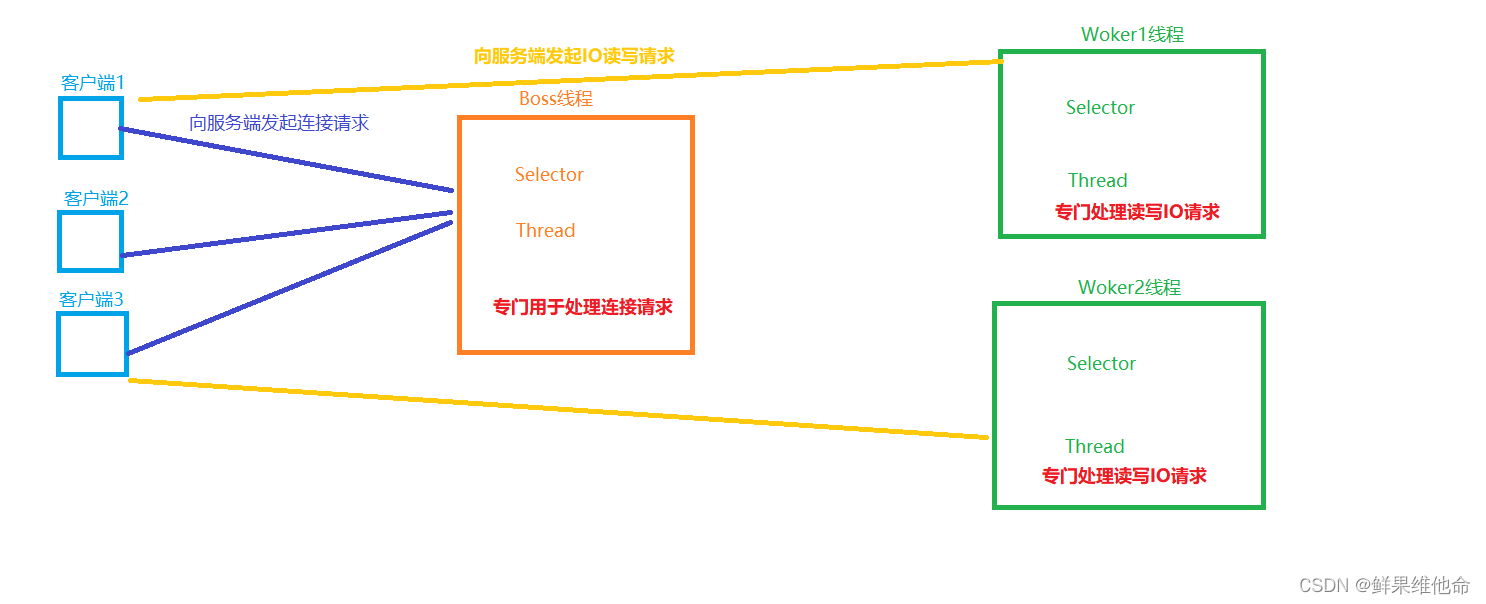Netty框架之多线程的Selector优化
学习Selector之后,我们发现单个Selector轮询器在一个线程中既要处理 连接事件(OP_ACCPET),又要处理 IO读写事件(OP_READ,OP_WRITE),效率是很低的,所以利用多线程创建多个Selector分别负责连接事件,IO读写事件,充分利用电脑的CPU资源.
那么这里我们就分类两个线程:
1.Boss线程:专门负责OP_ACCPET事件,也就是连接事件
2.Woker线程:专门负责OP_READ和OP_WRITE事件,也就是IO读写事件

1.一个Boss线程,一个Woker线程实现服务器
import java.io.IOException;
import java.net.InetSocketAddress;
import java.nio.ByteBuffer;
import java.nio.channels.*;
import java.nio.charset.Charset;
import java.util.Iterator;
import java.util.concurrent.ConcurrentLinkedQueue;
/**
* 多线程结合selector优化,充分利用CPU资源
* 一个boss线程,一个woker线程
* boss专门负责处理连接请求,woker专门负责处理IO读写请求
*/
public class WokerTest {
public static void main(String[] args) throws Exception {
ServerSocketChannel ssc = ServerSocketChannel.open();
ssc.configureBlocking(false);
Selector boss = Selector.open();
ssc.bind(new InetSocketAddress(8080));
SelectionKey ssck = ssc.register(boss, 0, null);
//设置只关心连接事件
ssck.interestOps(SelectionKey.OP_ACCEPT);
Woker woker = new Woker("woker-0");
//处理连接请求
while(true){
//如果有连接请求就处理连接,如果没有就阻塞
boss.select();
Iterator<SelectionKey> iterator = boss.selectedKeys().iterator();
while(iterator.hasNext()){
SelectionKey sk = iterator.next();
SocketChannel sc =(SocketChannel)sk.channel();
//设置为非阻塞模式
sc.configureBlocking(false);
//注册到woker中,让woker负责此通道的IO处理
woker.registe(sc);
}
}
}
static class Woker implements Runnable{
private String name;
private Selector WokerSelector;
private Thread thread;
private boolean flag=false;
private ConcurrentLinkedQueue<Runnable>queue = new ConcurrentLinkedQueue<>();
//注册通道SocketChannel到Selector(一直有,一直做),并且完成WokerSelector和thread的初始化工作(仅一次)
public void registe(SocketChannel sc) throws Exception {
//初始化工作还没有做,那么完成初始化工作
if(flag==false){
flag = true;
WokerSelector = Selector.open();
thread = new Thread(this,name);
thread.start();
}
queue.add(()->{
try {
sc.register(WokerSelector,0,null);
} catch (ClosedChannelException e) {
e.printStackTrace();
}
});
WokerSelector.wakeup();//唤醒WokerSelector
}
public Woker(String name){
this.name = name;
}
@Override
public void run() {
SelectionKey sk = null;
ByteBuffer buf = ByteBuffer.allocate(1024);
//把读写事件的通道Socketchannel注册到WokerSelector,并且完成读写事件的处理
while(true){
try {
/*如果有读写事件要处理,没有就阻塞
如果有通道需要注册,可以通过WokerSelector.wakeup()唤醒WokerSelector*/
WokerSelector.select();
//如果有通道Socketchannel需要注册道WokerSelector
Runnable task = queue.poll();
//队列可能为空,此时poll()不会抛异常而是返回null值
if(task!=null){
//完成注册事件
task.run();
}
Iterator<SelectionKey> iterator = WokerSelector.selectedKeys().iterator();
while(iterator.hasNext()){
sk = iterator.next();
iterator.remove();
SocketChannel sc = (SocketChannel)sk.channel();
sc.read(buf);
buf.flip();
//读取信息
System.out.println(Charset.defaultCharset().decode(buf));
buf.clear();
}
} catch (IOException e) {
e.printStackTrace();
//事件要么被处理,要么被取消,不然会一直触发WokerSelector.select();
if(sk!=null) sk.cancel();
}
}
}
}
}
2.一个Boss线程,多个Woker线程实现服务器
与一个Woker线程不同的区别在于,如何把IO读写事件均分到多个Woker线程中,使得并发效率得到提升,减少单个Woker的处理压力
/*注册到多个woker中,让woker负责此通道的IO处理
这里用pos变量来实现负载均衡*/
wokers[pos.getAndIncrement()%number].registe(sc);
完整代码
import java.io.IOException;
import java.net.InetSocketAddress;
import java.nio.ByteBuffer;
import java.nio.channels.*;
import java.nio.charset.Charset;
import java.util.Iterator;
import java.util.concurrent.ConcurrentLinkedQueue;
import java.util.concurrent.atomic.AtomicInteger;
/**
* 多线程结合selector优化,充分利用CPU资源
* 一个boss线程,多个woker线程
* boss专门负责处理连接请求,woker专门负责处理IO读写请求
*/
public class WokersTest {
public static void main(String[] args) throws Exception {
ServerSocketChannel ssc = ServerSocketChannel.open();
ssc.configureBlocking(false);
Selector boss = Selector.open();
ssc.bind(new InetSocketAddress(8080));
SelectionKey ssck = ssc.register(boss, 0, null);
//设置只关心连接事件
ssck.interestOps(SelectionKey.OP_ACCEPT);
//wokers个数最好设置为物理机的CPU核数,通过Runtime.getRuntime().availableProcessors()获取
int number = Runtime.getRuntime().availableProcessors();
Woker[]wokers = new Woker[number];
AtomicInteger pos = new AtomicInteger(0);
//处理连接请求
while(true){
//如果有连接请求就处理连接,如果没有就阻塞
boss.select();
Iterator<SelectionKey> iterator = boss.selectedKeys().iterator();
while(iterator.hasNext()){
SelectionKey sk = iterator.next();
SocketChannel sc =(SocketChannel)sk.channel();
//设置为非阻塞模式
sc.configureBlocking(false);
/*注册到多个woker中,让woker负责此通道的IO处理
这里用pos变量来实现负载均衡*/
wokers[pos.getAndIncrement()%number].registe(sc);
}
}
}
static class Woker implements Runnable{
private String name;
private Selector WokerSelector;
private Thread thread;
private boolean flag=false;
private ConcurrentLinkedQueue<Runnable>queue = new ConcurrentLinkedQueue<>();
//注册通道SocketChannel到Selector(一直有,一直做),并且完成WokerSelector和thread的初始化工作(仅一次)
public void registe(SocketChannel sc) throws Exception {
//初始化工作还没有做,那么完成初始化工作
if(flag==false){
flag = true;
WokerSelector = Selector.open();
thread = new Thread(this,name);
thread.start();
}
queue.add(()->{
try {
sc.register(WokerSelector,0,null);
} catch (ClosedChannelException e) {
e.printStackTrace();
}
});
WokerSelector.wakeup();//唤醒WokerSelector
}
public Woker(String name){
this.name = name;
}
@Override
public void run() {
SelectionKey sk = null;
ByteBuffer buf = ByteBuffer.allocate(1024);
//把读写事件的通道Socketchannel注册到WokerSelector,并且完成读写事件的处理
while(true){
try {
/*如果有读写事件要处理,没有就阻塞
如果有通道需要注册,可以通过WokerSelector.wakeup()唤醒WokerSelector*/
WokerSelector.select();
//如果有通道Socketchannel需要注册道WokerSelector
Runnable task = queue.poll();
//队列可能为空,此时poll()不会抛异常而是返回null值
if(task!=null){
//完成注册事件
task.run();
}
Iterator<SelectionKey> iterator = WokerSelector.selectedKeys().iterator();
while(iterator.hasNext()){
sk = iterator.next();
iterator.remove();
SocketChannel sc = (SocketChannel)sk.channel();
sc.read(buf);
buf.flip();
//读取信息
System.out.println(Charset.defaultCharset().decode(buf));
buf.clear();
}
} catch (IOException e) {
e.printStackTrace();
//事件要么被处理,要么被取消,不然会一直触发WokerSelector.select();
if(sk!=null) sk.cancel();
}
}
}
}
}
